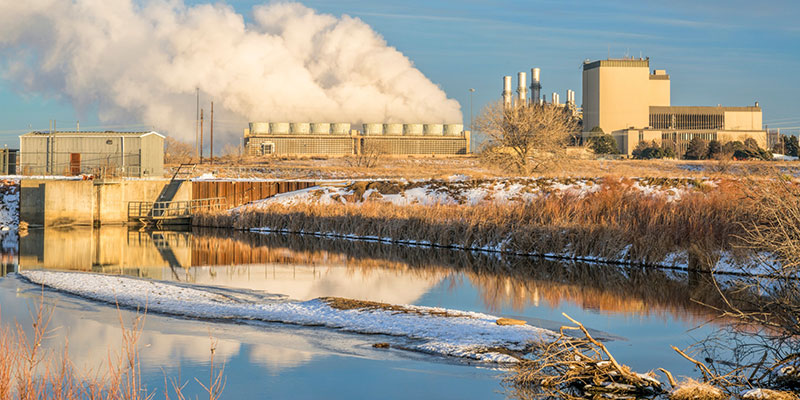One opportunity for the use of recycled industrial wastewater is for cooling at electrical generation plants.
Combining tried-and-true techniques with more advanced methods can produce desired results
The world of industrial wastewater treatment is undergoing a transformative phase with the emergence of innovative methods and technologies. Treating industrial wastewater is a complex process that requires careful consideration of the unique characteristics of each wastewater stream.
Yet, traditional processes still have a place, giving industries a diverse range of solutions to choose from. By embracing advancements and integrating sustainable practices, industries can effectively manage their wastewater while protecting the environment, and contributing to a circular economy.
Traditional Treatment Processes
The main goal of wastewater treatment is to speed up the natural processes by which water is purified so that it can be safely discharged into the environment. Traditional wastewater treatment relies on several steps, including:
- Physical Treatment: Physical treatment methods during primary treatment include the removal of solid particles and contaminants with processes like sedimentation, filtration, and screening.
- Biological Treatment: Biological treatment methods in secondary treatment use specific microorganisms to break down organic compounds. In aerobic processes, this takes place in the presence of oxygen, producing carbon dioxide and water. In anaerobic processes, special bacteria convert organic substances into methane and carbon dioxide outside the presence of oxygen.
- Chemical Treatment: Chemical processes, usually in tertiary treatment, remove dissolved substances and contaminants with chemical reactions or additives. For example, in coagulation and flocculation, chemicals are added to induce particle aggregation and settling. Oxidation, pH adjustment, and reduction reactions are used to neutralize acidity or alkalinity, remove specific contaminants, or enhance biodegradation. Chemical treatment is effective in targeting specific pollutants and pathogens to improve overall water quality.
While these time-honored processes still hold a place in modern treatment trains, they’re joined by more recent techniques.
Advanced Technologies for Treating Industrial Wastewater
With more stringent effluent discharge regulations in place, and wastewater increasingly being recycled for reuse, there is a growing need for advanced treatment technologies that produce higher-quality effluent. These technologies include:
- Advanced Oxidation Processes: In advanced oxidation processes (AOPs) strong oxidants such as ozone, hydrogen peroxide, and ultraviolet (UV) light degrade persistent organic compounds and other pollutants in wastewater. AOPs generate highly reactive hydroxyl radicals that break down complex organic molecules into simpler, more biodegradable forms. These processes are effective in treating wastewater with refractory compounds or pharmaceutical residues.
- Membrane Technologies: Membrane-based technologies, including reverse osmosis (RO), ultrafiltration (UF), and nanofiltration (NF), are widely used to separate and concentrate dissolved solids, contaminants, and suspended particles. RO utilizes a semipermeable membrane to remove salts and impurities, while UF and NF membranes effectively remove particles, bacteria, and macromolecules. Membrane technologies are particularly useful for treating wastewater for reuse and for the recovery of valuable resources from wastewater.
Effluent treated with these steps can be safely reused for applications including irrigation, industrial processes, managed aquifer recharge, and even as drinking water.
Sustainable Approaches
In recent years, there has been a growing emphasis on adopting sustainable practices in industrial wastewater treatment. This includes integration of renewable energy sources to power treatment processes, reducing an operation’s carbon footprint.
Water reuse and recycling initiatives are gaining traction, enabling industries to conserve water resources and minimize the impact on freshwater supplies.
Green infrastructure solutions, such as constructed wetlands or biofiltration systems, are being explored for their natural ability to purify wastewater in a cost-effective and environmentally friendly way. In these solutions, plants are used to take up nutrients and living microorganisms are used to biodegrade contaminants in wastewater.
Water Reuse and Waste-to-Energy
Fluence offers several sustainable technologies for treating industrial wastewater that are environmentally-friendly, energy-efficient, and cost-efficient, including the following water reuse and waste-to-energy solutions.
- Anaerobic Membrane BioReactor (An-MBR): An-MBR treatment combines anaerobic digestion with MBR technologies that concentrates the solid digestate using a micro- or ultrafiltration membrane with a suspended growth bioreactor instead of conventional centrifuges or dissolved air flotation.
- Tertiary Treatment for Industrial Reuse: Advanced treatment technologies, such as ultrafiltration, reverse osmosis, ozonation, ultraviolet (UV) disinfection, and advanced oxidation can be used in combination with primary and secondary treatment to recycle wastewater for use in industrial applications such as process water and ultrapure water.
- Waste-to-energy: Industrial wastewater with a high organic load can be treated in an anaerobic digester, where anaerobic methanogenic bacteria break down the organic material, producing methane, which is captured and used as a valuable source of energy. The resulting nutrient-rich digestate that can be used as a soil enhancer.
While different industries produce effluent with different characteristics, Fluence can tailor a recycling or waste-to-energy solution for a range of industries, including dairy processors; meat and fish processors; fruit, soft drink, and confectionary industries; breweries; and paper and pulp industries.
Future Outlook for Wastewater Treatment
Industrial wastewater treatment requires a tailored approach to address the specific characteristics and contaminants of each wastewater stream. By employing a combination of physical, biological, chemical, and advanced technologies, industries can effectively treat and manage their wastewater, minimizing environmental impact and ensuring regulatory compliance. Each method and technology offers unique advantages and applications, and the selection depends on factors including wastewater composition, treatment objectives, and cost considerations.
Ongoing research and development efforts in this field promise a future where industries can achieve both economic growth and environmental stewardship through efficient and sustainable wastewater treatment practices. Contact Fluence to learn how you can improve environmental and operational performance while also reducing costs.

